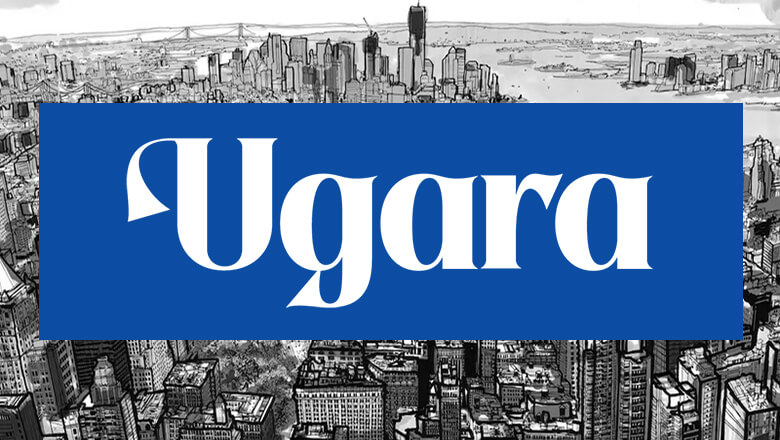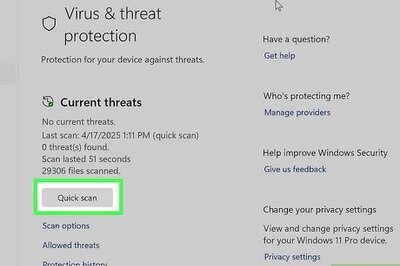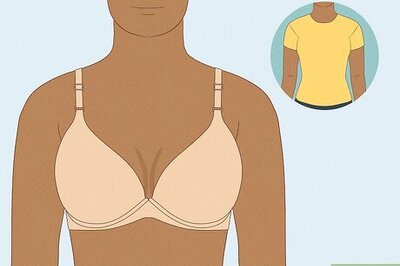
views
Can flexing build muscle?
Yes, flexing can build muscle, but not very effectively. According to studies, simply flexing your muscles can, in fact, make them bigger, but not by a dramatic amount. One study found that people assigned to a four-week flex training program saw a 4% increase in muscle size which, hey, isn’t nothing, but 4% also isn’t the most impressive number. Personal trainer Jesse Pichardo tells us if you only flexed during training, you “wouldn’t build any strength.” Flexing is what’s known as an isometric exercise, meaning it strains the muscles, but doesn’t move them. For this reason, it can improve your strength in that one position, but isn't super effective for improving overall strength. For that reason, flexing also won’t burn fat or make your abs look better, at least, not when you're not flexing. As an exercise, it builds a little muscle, but doesn’t drop weight, like cardio does.
Benefits of Flexing
Flexing helps you maintain your level of strength. While flexing isn’t the best exercise for building strength, isometric exercises like flexing can help you maintain your current strength. Flexing is a great supplement to other muscle-building exercises, and can help you make sure you don’t lose your gains on an off-week. This also makes isometric exercises a good, low-intensity workout for people who want to maintain a physique without losing or gaining more muscle.
Flexing improves your muscle stability. Isometric exercises like flexing improve strength in certain positions, like while holding a weight or keeping your body upright during an exercise. Though it doesn’t build a whole lot of muscle, it helps your body and core stabilize, which primes you for exercises that do build muscle. For example, flexing might not help you bench press those huge amounts of weight, but it will improve your control and grip on the bar.
Flexing can be used to rehab injured muscles. Studies show that low-impact isometric exercises, like muscle flexing, are great for recovering athletes and people trying to bounce back from an injury. They don’t push your body as much as cardio or weight training exercises, and help you get back into the swing of things without hurting yourself further. That said, there’s still the possibility of injury. Only use isometric exercises as rehab with the help of a physical therapist or trainer.
Flexing is a great starting point for fitness beginners. Since isometric exercises are easy to do and don’t strain the body too much, they’re a great choice for people who are new to things like muscle training. It helps them get a feel for their body and its capabilities, and can be much more approachable than hitting the weights right away.
Flexing can reduce high blood pressure. People with high blood pressure are often advised to exercise at a lower intensity to lower the risk of elevating their blood pressure even further. Isometric exercises are a great solution, since they don’t strain the body too much, and they also don’t elevate your heart rate as much as other forms of exercise.
Best Flexing Exercises
Planks To do a plank, kneel on the floor, then place your forearms parallel on the floor, about shoulder-length apart. Rise up onto your toes, and make the entire trunk of your body forms a straight line. Hold that position for 10-30 seconds, or as long as you can. Aim for 1-6 reps each workout. Benefits: Improves your core strength and works your abs, arms, and legs.
Wall sits To do a wall sit, stand with your back flat against a wall. Walk your legs forward about 2 ft (0.61 m), a bit wider than shoulder-width apart, or until your knees are bent at a 90-degree angle, while your back is still straight against the wall. Hold this pose for 20-60 seconds, then stand. Perform this exercise 1-6 times per workout. Benefits: Strengthens your core, legs, and glutes.
Dead hangs To do a dead hang, find a pullup bar. Grip it with your palms facing away from you, then hang from it, without lifting yourself up or down, and with your arms straight. Hang for 30-60 seconds, and repeat this exercise 4-5 times per workout. Benefits: Strengthens your arms, shoulders, and core.
Glute bridges To do a glute bridge, lie flat on your back on a yoga mat or a flat surface. Plant your feet flat on the floor, shoulder-width apart. Then, raise your pelvis in the air, so that your knees are bent about 90 degrees. Hold that position for 30-60 seconds, and repeat the exercise 3-4 times per workout. Benefits: Strengthens your core, legs, and glutes.
Squat holds To do a squat hold, stand with your legs wide apart. Then, bend your legs until your knees are bent about 90 degrees, keeping your center of gravity over your feet. Hold that position for 30-60 seconds, then straighten. Repeat this exercise 5-6 times per workout. Benefits: Strengthens your core, legs, and glutes.
Shoulder extensions To do a shoulder extension, stand with your back flat against a wall, keeping your arms straight at your sides. Place your your palms against the wall, and push against it for 5 seconds while keeping your body stationary, then relax. Repeat this 5-10 times, and do 3 sets per workout. Benefits: Strengthens your arms and shoulders.
Shoulder rotations Stand straight against the corner of a wall. Bend your arm 90 degrees and place your palm flat against the perpendicular surface of the wall for an internal rotation, or place the back of your hand against it for an external rotation. Press your hand into the wall for 5 seconds, then relax, and repeat 10 times. Do 3 sets per workout. Benefits: Strengthens your arms, shoulders, and neck.
How do muscles grow?
Muscles grow by being torn and repaired on a microscopic level. “To build strength and muscle you need to overload the muscle,” Pichardo tells us. When you overload the muscle, you make microscopic tears in the muscle fibers, which your body then repairs with new tissue, which makes them grow and become stronger. When the fibers tear, lactic acid acts as a signal for your body to repair them, like construction cones. Then, your muscle fibers enlarge in a process known as “hypertrophy.” During hypertrophy, “satellite cells” that surround your muscles fuse, grow, and divide, becoming new and thicker muscle fibers, making your muscles bigger and stronger. That’s why simply flexing doesn’t build much muscle—you’re not overloading your muscles by very much, so you’re not tearing them very much, so they’re not being repaired and reinforced very much.
Building Muscle Effectively
Push your limits, but don’t overdo it. The key to muscle growth is resistance exercise, which is things like weight training or body weight exercises. When you do resistance training, find your limits gradually by starting with a small amount of weight, and add weight in small increments, until you’re straining but not struggling. Then, keep adding small amounts of weight to help your body push past its limits. Generally, aim to work out each major muscle group (chest, abs, shoulders, arms, legs, hips, back) 2 or more times each week. Ultimately, practicing proper form is more important than lifting a lot of weight, though. Goof dorm targets your muscles, while too much weight is inefficient and can cause injuries. For muscle growth, short and intense workouts are better than long and easy workouts.
Give each muscle group a couple days of rest between workouts. Muscle growth happens mostly in the recovery stage, when your muscles have time and energy to recover. After working a certain muscle group, give it a couple of days to rest, and focus on a different group on those days. Personal trainer Alphonso White tells us to get 7-8 hours of sleep each night while training, which gives your muscles plenty of rest.
Balance your protein, carbs, and fat intake. Diet is also key to muscle growth, but each person’s diet is different. Generally, adults need about 1,600-3,000 calories each day. Of those calories, 10-35% of of them should be protein, 50% from carbs, and 20-35% from fats. How many calories you need each day depends on your age, height, and weight. Use an online calorie calculator to find your specific number.
Work with a personal trainer for the best results. A personal trainer can create a personalized fitness regimen customized to your own goals and body type, and also help you build muscle quickly without hurting yourself. If you’re serious about building muscle, a personal trainer is a great path.
How quickly can I build my muscles?
Most people see results of muscle training after about 6 weeks. Don’t expect dramatic results just from flexing alone, but if you’re doing resistance training, you’ll feel yourself getting stronger pretty quickly, after only 2 or 3 30-minute sessions. How quickly you’ll see results depends on a lot of things, like your weight, age, and build, but most people see visible growth in about 8 weeks of regular training. To motivate you, go ahead and stand in the mirror and flex! Even take a selfie or two to track your progress. That’s another benefit of flexing: it feels good, looks good, and makes you want to work harder.




















Comments
0 comment